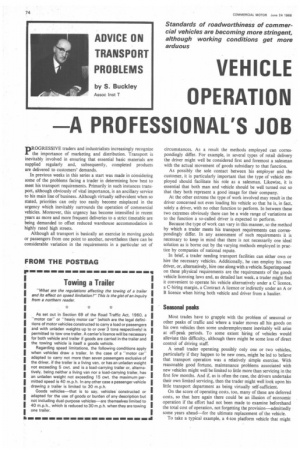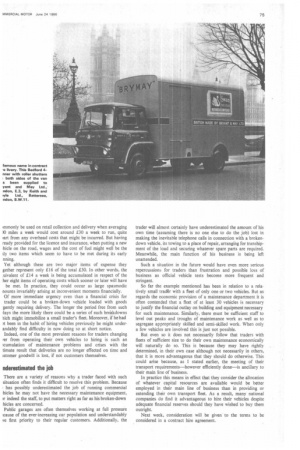VEHICLE OPERATION A PROFESSIONAL'S JOB
Page 76

Page 77

If you've noticed an error in this article please click here to report it so we can fix it.
DROGRESSIVE traders and industrialists increasingly recognize
the importance of marketing and distribution. Transport is inevitably involved in ensuring that essential basic materials are supplied regularly and, subsequently, completed products are delivered to customers' demands.
In previous weeks in this series a start was made in considering some of the problems facing a trader in determining how best to meet his transport requirements. Primarily in such instances transport, although obviously of vital importance, is an ancillary service to his main line of business. Although virtually self-evident when so stated, priorities can only too easily become misplaced in the urgency which inevitably surrounds the operation of commercial vehicles. Moreover, this urgency has become intensified in recent years as more and more frequent deliveries to a strict timetable are being demanded to offset reduced warehouse accommodation in highly rated high streets.
Although all transport is basically an exercise in moving goods or passengers from one point to another, nevertheless there can be considerable variation in the requirements in a particular set of circumstances. As a result the methods employed can correspondingly differ. For example, in several types of retail delivery the driver might well be considered first and foremost a salesman with the actual movement of goods subsidiary to that function.
As possibly the sole contact between his employer and the customer, it is particularly important that the type of vehicle employed should facilitate his role as a salesman. Likewise, it is essential that both man and vehicle should be well turned out so that they both represent a good image for their company.
At the other extreme the type of work involved may result in the driver concerned not even loading his vehicle so that he is. in fact, solely a driver, with no other function to perform. In between these two extremes obviously there can be a wide range of variations as to the function a so-called driver is expected to perform.
Because the type of work can vary in this manner, so the method by which a trader meets his transport requirements can correspondingly differ. In any assessment of such requirements it is necessary to keep in mind that there is not necessarily one ideal solution as is borne out by the varying methods employed in practice by companies of national repute.
In brief, a trader needing transport facilities can either own or hire the necessary vehicles. Additionally, he can employ his own driver, or, alternatively, hire one along with a vehicle. Superimposed on these physical requirements are the requirements of the goods vehicle licensing laws and, as detailed last week, a trader might find it convenient to operate his vehicle alternatively under a C licence, a C-hiring margin. a Contract A licence or indirectly under an A or B licence when hiring both vehicle and driver from a haulier.
Seasonal peaks
Most trades have to grapple with the problem of seasonal or other peaks of traffic and where a trader moves all his goods on his own vehicles then some underemployment inevitably will arise at off-peak periods. To some extent hiring of vehicles would alleviate this difficulty, although there might be some loss of direct control of driving staff.
A small trader operating possibly only one or two vehicles, particularly if they happen to be new ones, might be led to believe that transport operation was a relatively simple exercise. With reasonable good fortune, maintenance problems associated with new vehicles might well be limited to little more than servicing in the first few months. And if, as is often the case, the drivers undertake their own limited servicing, then the trader might well look upon his little transport department as being virtually self-sufficient.
On the score of operating costs, too, many of these are deferred costs, so that here again there could be an illusion of economic operation if the effort had not been made to examine beforehand the total cost of operation, not forgetting the provision—admittedly some years ahead—for the ultimate replacement of the vehicle.
To take a typical example, a 4-ton platform vehicle that might .mmonly be used on retail collection and delivery when averaging )0 miles a week would cost around £30 a week to run, quite )art from any overhead costs that might be incurred. But having ready provided for the licence and insurance, when putting a new hide on the road, wages and the cost of fuel might well be the ily two items which seem to have to be met during its early nning.
Yet although these are two major items of expense they gether represent only £16 of the total £30. In other words, the ,uivalent of £14 a week is being accumulated in respect of the her eight items of operating costs which sooner or liter will have be met. In practice, they could occur as large spasmodic nounts invariably arising at inconvenient moments financially. Of more immediate urgency even than a financial crisis for trader could be a broken-down vehicle loaded with goods gently requiring delivery. The longer the period free from such days the more likely there could be a series of such breakdowns htich might immobilize a small trader's fleet. Moreover, if he had A been in the habit of hiring vehicles previously he might underandably find difficulty in now doing so at short notice.
Indeed, one of the most prevalent reasons for traders changing ler from operating their own vehicles to hiring is such an :cumulation of maintenance problems and crises with the timate result that deliveries are no longer effected on time and istomer goodwill is lost, if not customers themselves.
nderestimeted the job
There are a variety of reasons why a trader faced with such situation often finds it difficult to resolve this problem. Because has possibly underestimated the job of running commercial hides he may not have the necessary maintenance equipment, or indeed the staff, to put matters right as far as his broken-down hides are concerned.
Public garages are often themselves working at full pressure :cause of the ever-increasing car population and understandably ye first priority to their regular customers. Additionally, the trader will almost certainly have underestimated the amount of his own time (assuming there is no one else to do the job) lost in making the inevitable telephone calls in connection with a brokendown vehicle, its towing to a place of repair, arranging for transhipment of the load and securing whatever spare parts are required. Meanwhile, the main function of his business is being left unattended.
Such a situation in the future would have even more serious repercussions for traders than frustration and possible loss of business as official vehicle tests become more frequent and stringent So far the example mentioned has been in relation to a relatively small trader with a fleet of only one or two vehicles. But as regards the economic provision of a maintenance department it is often contended that a fleet of at least 30 vehicles is necessary to justify the financial outlay on building and equipment necessary for such maintenance. Similarly, there must be sufficient staff to level out peaks and troughs of maintenance work as well as to segregate appropriately skilled and semi-skilled work. When only a few vehicles are involved this is just not possible.
But even so it does not necessarily follow that traders with fleets of sufficient size to do their own maintenance economically will naturally do so. This is because they may have rightly determined, in their own case although not necessarily in others, that it is more advantageous that they should do otherwise. This could arise because, as I stated earlier, the meeting of their transport requirements—however efficiently done—is ancillary to their main line of business.
In practice this means in effect that they consider the allocation of whatever capital resources are available would be better employed in their main line of business than in providing or extending their own transport fleet. As a result, many national companies do find it advantageous to hire their vehicles despite adequate financial reserves should they have wished to buy them outright.
Next week, consideration will be given to the terms to be considered in a contract hire agreement.
























































































































